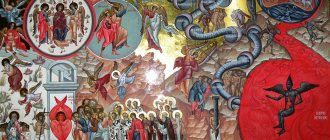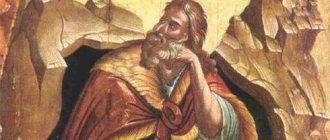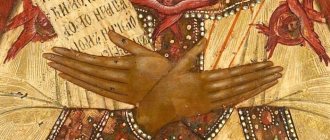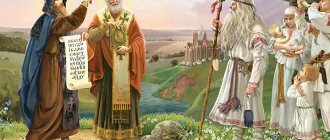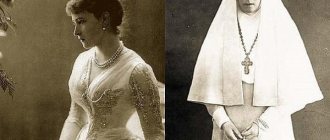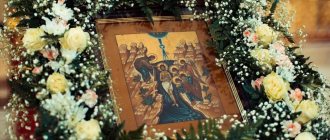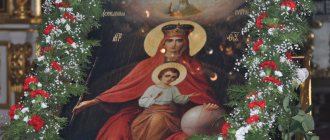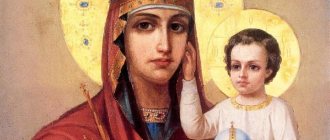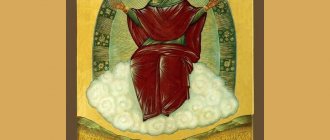Christianity is a holistic worldview that includes ideas not only about the lifelong existence of a person, but also about the posthumous existence. In the Holy Scriptures you can read about how the world was created and about what its last days will be like. According to this most widespread religion in the world, the Second Coming of Christ will soon await us. And when this happens, the righteous will go to heaven, and sinners will be punished.
These future events are described in detail not only in the Bible. The subjects of icons are often dedicated to them. Images that present the viewer with pictures of the Last Judgment are found in many churches in Russia. Their technique may be different. However, the composition of all Last Judgment icons and their scenes are usually determined by the canons.
History of addition
Icon painters began depicting scenes of the Last Judgment a very long time ago. The first paintings and images of this type appeared in Byzantium. For example, several similar icons and temple paintings dating back to the 4th century are known. At that time in Byzantium, such images usually described the parables of the separation of sheep and goats, as well as of the ten virgins.
Icon “The Last Judgment”, late 14th – early 15th centuries (Moscow, Assumption Cathedral)
The canonical plot of the Last Judgment was also formed in Byzantium, around the 18th century. In Rus', such icons began to be painted almost from the very baptism. But the very first such image was recorded by historians on the walls of the Kyiv Cyril Monastery. Somewhat later, scenes of the Last Judgment appeared in the Dmitrov Cathedral, the Church of the Savior Nereditsa and the St. George Church.
The Last Judgment icon traditionally includes three themes:
Topic 1. The Second Coming of Jesus Christ . The Savior is the dominant feature of the icon. He can often be seen surrounded by the Mother of God, John the Baptist, angels or apostles. Jesus Christ acts as a judge who divides people into righteous and sinners.
Topic 2. Renewal of the world. These are various signs of change. Here angels fight demons and blow trumpets, unclean spirits and sinners burn in fiery hell, and souls line up before the judgment seat. The dead are rising everywhere. The allegorical earth in the form of a woman disgorges the dead, and birds and fish do the same.
Topic 3. Heavenly Jerusalem . Almost always the city in which the righteous live is depicted at the top. Some are just heading there and are depicted in flight. Usually these are schema-monks. Angels are hovering everywhere, and two of them are rolling up a scroll (the sky) - this is a symbol of the end of the world.
As for Mother Rus', the Last Judgment icon began to appear almost immediately after baptism. Historians call the first monastery where this icon was noticed the St. Cyril Monastery. Later it was noticed that the plot of the icon was completely divided into the court scene and the image of the Apocalypse, which became the reason for their official separation.
The earliest icons depicted not only the trial itself, but also scenes from the Apocalypse. Later these two stories were separated. Initially, the canons determined only which scenes should be depicted in the image. The icon painters chose their location themselves. The plot and composition were fully approved by the Church only in the 16th-17th centuries. By this time, each scene of the Last Judgment had taken its place on the icons.
Texts that influenced the iconography of the Last Judgment
In the developed form, the iconography of the Last Judgment is based on the texts of the Gospel, the Apocalypse, as well as patristic works: the “Words” of Ephraim the Syrian, the Words of Palladius Mnich, “The Life of Basil the New” and other works of Byzantine and Old Russian literature; in the next period, texts of folk spiritual poems can also be seen in iconographic details.
- One of the most important sources that influenced the composition and character of the compositions of the Last Judgment was the Life of Basil the New (10th century).
- Vision of the Prophet Daniel (Dan. 10-12) - in the scene “Vision of the Prophet Daniel,” an angel shows the prophet Daniel four animals. These beasts symbolize the “perishing kingdoms” (kingdoms that are about to perish) - Babylonian, Macedonian, Persian and Roman, or the Antichrist. The first is represented in the form of a bear, the second in the form of a griffin, the third in the form of a lion, and the fourth in the form of a horned beast. Sometimes other animals were also written that had an allegorical meaning. Among the latter, hares are especially interesting, which, according to a widespread idea in Rus', embodied in poems about the “Pigeon Book,” were allegorical images of truth (white hare) and “falsehood” (gray hare).
- The fiery stream (river) is known from the so-called “Walking of the Mother of God through torment,” one of the most popular apocrypha in ancient Russian writing. In the lists of the “Walk”, starting from the 12th century, it is indicated that “ in this river there are many husbands and wives;
some are immersed to the waist, others to the chest, and only others to the neck ,” depending on the degree of their guilt.
The images of the Last Judgment had an important feature: they were created not to intimidate a person, but to make him think about his sins; “ do not despair, do not lose hope, but begin to repent
».
Repentance as an indispensable condition for achieving the Kingdom of God is one of the fundamental provisions of Christian doctrine, and this problem was especially relevant at the turn of the 11th-12th centuries, the time when the plot penetrated into Rus'.
Where did the composition come from?
The plot of these icons, of course, is based primarily on the description of the events set out in the Apocalypse. Also, some ancient Byzantine and Russian texts had a great influence on the canonical image - for example, the Life of Basil the New, the Word of Palladius Mnich, etc.
Many theologians and historians believe that another source from which the “Last Judgment” icon was painted is the revelation of the prophet Daniel. This saint, revered by all Christians, lived during the era of Babylonian captivity. Daniel is one of the last four great Jewish prophets.
Main scenes of the Last Judgment icon
The icon of the Last Judgment of God is primarily different from the rest of the presence of “bright” subjects that the Apocalypse prophesies. It depicts Adam and Eve - the first people on earth, and the apostles holding books in their hands, and the angels who stand behind them. In the hands of unearthly creatures is a scroll, which marks the completion, the finale of history on earth.
Some icon images require a separate interpretation:
- Dark and black figures are devils.
- The man in the hands of Satan is the soul of Judas.
- The long green snake is the Old Testament tempting serpent.
- A half-naked woman is the earth.
- A man and a woman are not far from Jesus Christ - Adam and Eve.
- A group of four angels are the most famous of the archangels: Michael, Gabriel, Raphael, Uriel.
- The flying figures are resurrected people.
- Bear, griffin, lion, horned beast - earthly kingdoms that will perish.
- A book is a book in which all the good and evil deeds of every soul are recorded.
- White and gray hares - true and false, respectively. Has nothing to do with Christianity. The symbol came from Slavic culture.
They, the heavenly inhabitants, surrounded Daniel, interpreting his prophecy. In addition, the Judgment Day icon is the only one among all Orthodox icons that shows the Creator with gray hair, in the form of an old man. Accompanied by Saints Peter and Paul, who lead the march, the immaculate righteous march.
This ends the main “light” scenes and is followed by the “dark” ones. These include the Serpent (the fiery river where human souls burn) - the personification of all earthly sins, the sitting or standing Antichrist, sometimes holding the soul of Judas in his palms, and also the four kingdoms of destruction, in place of which the Kingdom of Heaven will appear.
The icon of the Second Coming of Christ is not without scenes of neutral meaning, where sinners and the righteous stand before judgment. The first ones are dressed in ethnic costumes, as a symbol of all the nations of the world, and the saints are distributed by rank in two rows. Heaven and hell, scenes of the struggle between demons and angels. There is a dark circle around the Earth, a tomb and the sea - the resurrection of the dead. Good and evil, but sometimes there is an intermediate phenomenon, and this helps to understand a lost person who has not gone to heaven or hell.
First and second tier
All scenes in the Last Judgment images are usually arranged in three or four tiers. Of course, in the very center of these icons Christ is depicted with the Mother of God and John the Baptist. Adam and Eve fall at the feet of Jesus. On both sides of Christ on this tier stand the apostles. Above this scene, the Lord of Hosts himself and angels with a scroll are sometimes depicted.
Third and fourth tier
Below the scene with Christ and the apostles there is a throne with a robe. On both sides of him are those who have risen for judgment.
The next, lowest, tier usually occupies a significant part of the icon. The center of the composition in this place of the image is a hand with scales. Under it, according to the canons, there are scenes of battles between demons and angels. Also in this tier circles are drawn with the kingdoms, the woman-earth, the ark, the sea and the boat (on the right), as well as with the prophet Daniel (on the left).
The entire lower tier, as well as the third, is crossed by the writhing body of the serpent. On the left behind the circles are scenes of heaven. At the bottom right of the Last Judgment icon is an image of hell with the Antichrist. The merciful fornicator stands between these two scenes - in the middle. To his right is a procession of Old Testament righteous people leaving hell.
Snake image
This iconographic motif is unique and appeared on the Last Judgment images relatively recently. In paintings, the snake is usually depicted rising from hell to the feet of Adam kneeling before Jesus.
The basis for this scene, which is one of the key ones, was a story from the Bible about the curse of the first man by the Creator. On the body of the serpent in the Last Judgment icons, 20 rings are usually depicted. Each of them depicts a scene of those ordeals through which the human soul must go in order to get into the Kingdom of Heaven.
Sometimes icons depict a river of fire instead of a serpent. This plot is known from the work “The Virgin’s Walk through Torment.” Depending on the degree of guilt, people in the river can be immersed in fire up to their necks, chests or waists. Sometimes in the “Last Judgment” images, burning sinners are specified by social groups - nobility, crowned persons, etc.
Rublev's painting
In the Western European tradition, the image of the “Last Judgment” usually recalls the fires of the Inquisition. That is, it is often precisely a method of intimidation. God is depicted as angry, and sinners are clearly separated from the righteous. In the Russian tradition, “The Last Judgment” rather reminds us of God’s mercy. There is usually no clear distinction between lambs and goats in Orthodox images with a similar plot.
It is in this “merciful” style that, as we know, the most revered icon painter of Rus', Andrei Rublev, worked. Unfortunately, very little is known about his personality. However, of course, such a famous church artist could not ignore the very popular scenes of the Last Judgment icons that were often depicted in his time. Rublev chose these canonical scenes to decorate the Cathedral of the Assumption of the Virgin Mary in Vladimir. It is known that he began painting his fresco in 1408. The Last Judgment was depicted by Rublev on the western wall of the temple.
The icon painter placed the hand with the scales of the canonical plot on the end of the entrance arch at the top. Below it, the artist painted the prophets Daniel and Isaiah. Rublev depicted Christ himself on a blue background in the vault above the arch. Even higher, the icon painter painted two angels rolling up the old sky into a scroll. The animals, personifying the departing kingdoms, are depicted by Rublev in the arch leading under the dome. The artist placed the procession of the Old Testament righteous people to heaven under the leadership of Peter in the southern vault above the iconostasis. Opposite this scene, Rublev depicted paradise itself. Its first inhabitants - Adam and Eve - are drawn by the icon painter at the foot of the throne with the Gospel and a robe.
What is the significance of an icon for believers?
The icon of the Judgment of God, based on general interpretations, can evoke a feeling of fear and horror, but every person, whether he wants it or not, will ultimately face the Last Judgment, where all deeds will be judged.
The supreme judge there is Jesus Christ; it is he who, during the Second Coming, is destined to decide the fate of a person, sending the soul to eternal peace or torment.
The main thing is the essence of everything depicted - not to scare, but to force a person to rethink how he lives, what he does, whether he believes and sincerely repents after making a mistake.
Therefore, the church meaning of the icon of the Apocalypse is awareness of sins and repentance.
Prayer before the icon
This icon is usually not considered as an image for reading prayer. It carries rather a motivational load. But still, no one forbids you to pray in front of her, if you want.
The most logical solution is to read the “Our Father” prayer before it, or a special one about the salvation of the soul.
The prayer to the icon of the Last Judgment is focused on the atonement of sins not only through contemplation, but also by pronouncing cherished words that confirm sincere intentions. That is why it is necessary to pray in front of the icon for involuntary and voluntary sins, in order to gain the opportunity to enter the Heavenly Kingdom, and the commemoration of dead sinners is also allowed.
For on Thy Terrible One, and without respect for persons, I stand before the Judgment Seat, O Christ God, and raise condemnation, and create a word about the evil things I have done: this day, before the day of my condemnation even came, I stand before You at Your holy Altar, and before the terrible and holy Angels By yours, bowed by my conscience, I offer my wicked and lawless deeds, reveal this and expose it. See, Lord, my humility, and forgive all my sins, see how my iniquity has multiplied more than the hair of my head. Why haven't you done evil? What sin have I not committed? What evil have I not imagined in my soul? I have created every feeling and every evil that is defiled, corrupted, and indecent, having become a work of the devil in every way. And I know, Lord, that my iniquities have exceeded my head. But the multitude of Thy bounties is immeasurable, and the mercy of Thy kindness is inexpressible, and there is no sin, conquering Thy love for mankind. Moreover, Wonderful King, kindly Lord, surprise me, a sinner, with Thy mercy, show Thy goodness the power and show the strength of Thy gracious mercy, and when you turn, accept me, a sinner. Receive me as you received the prodigal, the robber, the harlot.
Receive me, having sinned You beyond measure in word and deed, with placeless lust and wordless thought. And just as at the one and tenth hour you accepted those who came, having done nothing worthy, so also accept me, a sinner: for many have sinned, and have become defiled, and have grieved Thy Holy Spirit, and grieved Thy humane womb, in deed, and in word, and in thought, in the night and in days, manifested and unmanifested, willingly and unwillingly. And we know that you have presented my sins before me as such, as I have committed, and have spoken with me about them who have sinned unforgivenly in their minds. But, Lord, Lord, do not reprove me with Thy righteous judgment, nor with Thy wrath, nor punish me with Thy wrath.
Have mercy on me, Lord, for I am not only weak, but also Your creation. For Thou, Lord, hast Thou established Thy fear upon me, and I have done evil before Thee, for Thee alone have sinned. But I pray to You, do not enter into judgment with Your servant. If you see iniquity, Lord, Lord, who will stand? Because I am the abyss of sin and am not worthy, below I am content to look and see the heights of heaven from the multitude of my sins, of which there is no number. Why haven't my sins been corrupted? Are Kiimi not kept evil? I have committed every sin, I have brought every uncleanness into my soul: it would be undesirable for You, my God, and for man. Who will raise me up, in the face of evil and a fraction of fallen sin?
Lord my God, I trust in You: if I have hope for salvation, if Your love for mankind overcomes the multitude of my iniquities, be me a Savior, and according to Your generosity and Your mercy, weaken, forgive, forgive me all, even if You have sinned, for I have been filled with many evils my soul, and there is within me the salvation of hope. Have mercy on me, O God, according to Your great mercy, and do not reward me according to my deeds, and do not judge me according to my deeds, but convert, intercede, and deliver my soul from the evils and cruel perceptions that co-increase with it. Save me for the sake of Thy mercy: that where sin abounds, Thy grace abounds. Grant me tears of contrition and tenderness of heart, leading the fallen to their inheritance, with them I will be cleansed from all sin, for it is a terrible and threatening place for the imam to pass through, bodies separated: then a multitude of dark and inhuman demons will overwhelm me, and no one will accompany or deliver me to help, but my works will condemn me. For this reason, before the end, receive me in repentance and never leave me, Thy servant, but always rest in me, do not betray me to the sedition of the serpent and do not leave me to the desires of Satan, for there is a seed of aphids in me.
Thou therefore, O Lord God worshiped, the Holy King, Jesus Christ, preserve me with Thy Holy Spirit, with whom Thou hast sanctified Thy disciples. Grant, O Lord, to me, Thy unworthy servant, too, Thy salvation: enlighten my mind with the light of understanding of Thy Holy Gospel, illuminate my soul with the love of Thy Cross, whiten my heart with the purity of Thy word, heal my body with Thy passionless passion, preserve my thought with Thy humility, and uplift me to do Thy commandments, and grant that with a cheerful heart and sober thought I may pass through the night of this present life, awaiting the coming of Thy bright and revealed day. You are, Lord, Light, more than any light, Joy, more than any joy, Hope, more than any hope, True Life and Salvation, which endures forever and ever. Amen!
Our Father
Our Father who art in heaven! Hallowed be Thy name; Thy kingdom come; Thy will be done on earth as it is in heaven; Give us this day our daily bread; and forgive us our debts, as we forgive our debtors; and lead us not into temptation, but deliver us from evil. For Yours is the kingdom and the power and the glory forever. Amen.
The plot in the paintings of artists
The Last Judgment was depicted not only in ancient times on various icons and temples, at the same time, various artists of various times depicted this vivid theme in their own canvases, therefore, it at one time found a place in modern painting.
The famous Michelangelo has a special fresco that is made on this theme, it is located on the Sistine Chapel.
There is also a picture that has an incredible effect on the person who sees it. It was made by the famous Hieronymus Bosch. In his work, the plot of Judgment Day is divided into three parts, in the central part the immediate judgment is depicted, at the head of which is Jesus Christ, on the left side is paradise, at the gate of which stands the Mother of God, and to the right of the Central image is the entrance, which is guarded by Satan. A person who has seen this picture at least once in his life can note that the composition is especially realistic.
In addition to the masters presented above, many artists used various biblical scenes of the Last Judgment in their works. Some depicted only parts of it, while others tried to bring to life the entire composition of this image; as a result of such actions, a large number of different options arose, which, unfortunately, are not very close to the Orthodox Church canons.
Words of the saints about the Last Judgment
A lot has been said about the Last Judgment both in the Holy Scriptures and in the sayings of saints. Many people held this image before their eyes to see the consequences of sins and spiritual negligence.
St. Theophan the Recluse spoke of constant preparation for the Second Coming of the Lord, without thinking about when it would be. He believed that this would certainly happen, but when was unknown.
St. John also believed that there was no point in guessing when the last day would happen, but there were terrible omens of the imminent end. These are various misfortunes and destruction, war and famine. The person himself will change and forget the laws of God. At this time, sins and evil will multiply.
So, all the holy fathers considered it important to remember the Second Coming and the Last Judgment. The icon with this image clearly helped in this, because its compositional series is designed in such a way as to see everything clearly and in detail (the heavenly bliss of the righteous and the hellish torment of sinners).
Oldest images
Unfortunately, most of the “Last Judgment” icons painted in ancient times, like many others, have not survived. However, several similar images have survived to this day. They were preserved mainly only as paintings in temples. The most famous image of this kind is the scene of the Last Judgment in the Church of Panagia Chalkeon in Thessaloniki, dating back to 1028. There are only two very ancient icons with such a plot in the world today. Both of them are located in the monastery of St. Catherine in Sinai. Another rather old image is the mosaic “Last Judgment” in the Basilica of Torcello in Venice.
Several ancient images with such a plot have been preserved in our country. The earliest icon of the Last Judgment in Russia is located in the Assumption Cathedral in the Kremlin.
